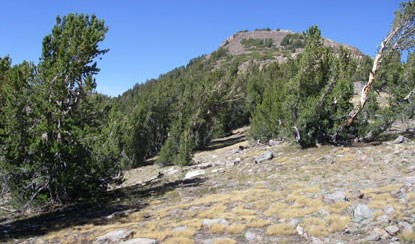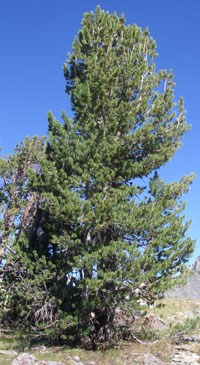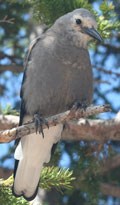
Yosemite National Park, home to one of the healthiest whitebark
pine populations, could become a potential refuge to a declining tree species
affected elsewhere by the white pine blister rust pathogen, mountain pine
beetle, and climate change.

Uncommon for a tree to receive such a high level of federal protection, whitebark pine is a major component of upper subalpine forests from northwestern Canada south to the Sierra Nevada and east to the Central and Northern Rocky Mountains. The Southern Sierra is the one region in the species’ entire range where it is relatively stable. In Yosemite, it grows at the top of the tree line, often in stunted krummholz stands, such as Parker Pass and Tioga Pass. It grows on cold, windswept sites, environments often too harsh for other species to thrive. The only North American member of the “stone pines,” whitebark pine depends entirely upon the Clark’s nutcracker for dispersal of its large, wingless seeds. Whitebark pine acts as both a foundation and keystone species in high-elevation forest communities by providing a high-energy food resource for wildlife, regulating ecosystem processes, community composition and dynamics, and by influencing regional biodiversity. 
Within Yosemite, the tree’s prime threats are present, unfortunately. Mountain pine beetle, native to North America, is in outbreak stage throughout much of the Western states. Here the beetle is known to have occurred but is not in an epidemic stage. White pine blister rust, an exotic Asian pest, was detected in 2010 on whitebark pine in a United States Geological Survey long-term monitoring plot on Mt. Gibbs. In addition, blister rust was detected on whitebark pine on Mt. Hoffmann by University of California researchers. Present in the park for decades, blister rust has affected sugar pines, which occur at lower elevations than whitebark pine. The Fish and Wildlife Service estimates that whitebark pine could disappear within two to three generations — from 120 to 180 years from now. Shawn McKinney, a Sierra Nevada Inventory & Monitoring ecologist, said “While I am profoundly saddened to realize whitebark pine decline has reached such a level to warrant federal listing, I am also buoyed by the fact that many people will now be aware of this pending calamity, which will hopefully spur innovation and funding to effectively sustain whitebark pine ecosystems.”
|
Last updated: October 7, 2019
